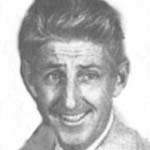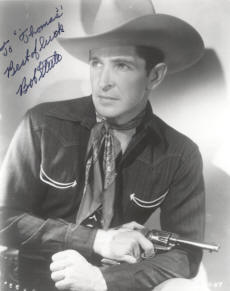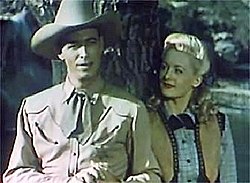Bob Steele stars in Lippert’s debut as producer
.
Robert L Lippert (1909 to 1976) was the owner of a big chain of movie theaters and drive-ins who was disgruntled at what he saw as the exorbitant prices demanded by movie studios for their pictures, and so after the Second World War he decided to make his own movies. He put together a company, Screen Guild, to produce films which he would distribute. He used directors who later became famous, such as Burt Kennedy, Samuel Fuller and James Clavell, and even struck it quite big with pictures such as I Shot Jesse James (1949) and The
Fly (1958).
Wanting to make a bit of an impact at the outset, Lippert splashed out on color for his first picture. Wildfire was shot in Cinecolor, much used at the time by smaller studios such as Monogram and PRC. Cinecolor was good at oranges and reds but couldn’t really handle other bright colors. The company lost money and closed in the 1950s, but not before a good many Westerns had been produced by the process.
Lippert chose Robert Emmett Tansey to direct. Tansey was an experienced hand at ultra-low-budget oaters in all sorts of capacities – director, editor, writer, production manager, and so on. He worked on several of those 30s Westerns starring John Wayne which were directed by RN Bradbury, and of course Bob Steele was Bradbury’s son.
I’ve always been a bit of a Bob Steele fan. Bob (Robert Adrian Bradbury) had started working with his dad on stage when he was two. Later he toured in a comedy Vaudeville act. His first screen experience was at age 14, in a silent Pathe production of Adventures of Bill and Bob with his twin brother Bill. He took the stage name Bob Steele in 1929 when he was 22 and successfully made the transition to talkies. He became a leading figure in the world of the low-budget Western, and eventually a very bankable star for Republic. He also appeared in character parts in some bigger pictures and became well known on TV. He is credited with a remarkable 171 feature Westerns, from the silent Daniel Boone Thru the Wilderness in 1926 to Something Big in 1971. Short, stocky, throwing a good punch, and a very athletic rider, he was well suited to our noble genre.
Wildfire also featured a couple of oldies, William Farnum as the dubiously honest judge, and Francis Ford (oddly mis-credited as Frances Ford) as a sympathetic horse trader. William and his brother Dustin were stars of the silent Western in the very early days. Bill had led in the first version of The Spoilers in 1914 and was Lassiter in the first screen version of Riders of the Purple Sage. When talking pictures came in he was relegated to character parts but he was still appearing in Westerns right through into the 1950s. Ford, John’s elder brother, had been one of the top directors and stars in early days but again had descended by the post-war era to taking whatever character parts he could get. He has a hundred feature Westerns to his credit, from 1917 to 1953.
The cast also included country & western songster Eddie Dean as a singin’ sheriff, well-known comic actor Sterling Holloway as Bob’s sidekick Alkali Jones, and stalwart Western baddy John Miljan, vet of dozens of oaters from a silent Harry Carey oater in 1925 to a Lone Ranger feature in the late 50s.
It must be said, though, that the acting was pretty awful, with the cast standing to attention and woodenly delivering the rather corny lines they had dutifully learnt. Ford was the only one who came across as the least convincing.
The plot (which is not the Zane Grey one) is one of the oldest going, the capture-the-wild-stallion wheeze. I don’t know how many times it’s been done – dozens, certainly. For some reason, no one can stand to see a splendid horse running free. As soon as they spot one, their first instinct is to rope the poor beast, and ‘break’ it – or even shoot it! It offends them to see the creature running wild, with no saddle or bridle on it. I was always, as a boy, on the side of the horse and wanted it to get away from the pesky humans, and I still am.
In Wildfire, some men who soon turn out to be henchmen of the local horse-stealing crook Fanning (Miljan) see the eponymous stallion running and of course immediately shoot at it. Unfortunately, one of them succeeds, wounding the poor critter in a front leg. Happy Haye (Steele) and his pard Alkali (Holloway) come across the wounded beast and you know what happens when a horse has a wounded leg… Happy draws his pistol while Alkali looks away. Yet nay, Happy can’t do it. He and Alkali decide they can heal the horse. They rig up a sling to take the weight off the equine tootsies and they doctor the wound. The horse seems to put up with this very docilely. And they succeed. Wildfire is cured. Hooray!
There follows a classic story of skullduggery, very familiar to us fans of the genre, with of course a dame in the mix. It’s Judy (Virginia Maples), a rancher who is under pressure from Fanning to sell – for naturally Fanning, like all good Western villains, wants the whole valley. Unfortunately poor Miss Maples was an even worse actor than the rest of the cast. Oh well. At first we think Happy has fallen for her but in fact she is the fiancée of the sheriff, and will wed him in the final scene.
Of course there are horse chases and fistfights and much shootin’ to go with the rootin’ and tootin’. Wildfire, eternally grateful to Bob and Alkali for having saved him, comes to the rescue of each one. There’s a final shoot-out at the bad guys’ cabin.
In all honesty, it’s very standard fare, with a distinct 30s look to it. Still, as I say, it does figure in a small way in the development of our splendid genre, and ought to be viewed at least once, I reckon. It’s on YouTube and won’t take but 57 minutes of your precious time, so give it a go.








One Response
Robert Lippert personally directed a western called Last of the Wild Horses in which an entire herd of wild horses is threatened by the bad guys. I've only seen the MST3K version, but it may be that wild horses were of particular interest to him.
Richard